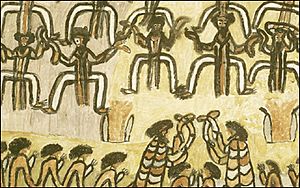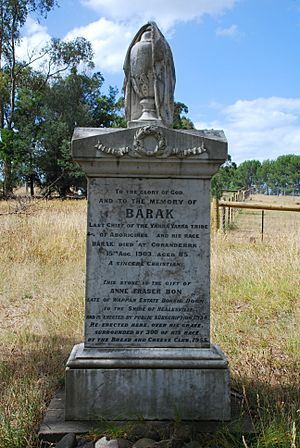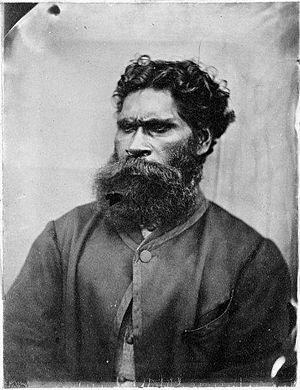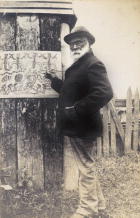William Barak facts for kids
William Barak, whose parents named him Beruk, was a very important Aboriginal leader. He was born in 1823 and passed away on August 15, 1903. He was the last traditional ngurungaeta (which means elder or leader) of the Wurundjeri-willam clan. This clan lived in the area we now call Melbourne, Australia, long before European settlers arrived.
Barak became a strong voice for Aboriginal people, fighting for fairness and justice. He also shared important knowledge about Wurundjeri culture and traditions. Later in his life, Barak created paintings and drawings that showed Wurundjeri ceremonies. He also carved traditional weapons and tools. Today, he is seen as a very important Aboriginal artist from the 1800s.
Contents
William Barak's Early Life
Barak was born in March 1823 (some say 1824) at Brushy Creek. This place is near what is now Wonga Park, named after his cousin, Simon Wonga. His mother, Tooterrie, was from the Nourailum bulluk people. His father, Bebejan, was an important leader, or ngurungaeta, of the Wurundjeri people. His parents gave him the name Beruk.
When he was a boy, Barak was said to be present when John Batman met with tribal elders. This meeting was about "buying" the Melbourne area in 1835.
Becoming a Wurundjeri Man
European settlement caused changes to traditional initiation ceremonies. To keep their culture strong, three important Wurundjeri leaders taught young Barak about Aboriginal traditions. These leaders were Ninggalobin, Poleorong, and Billibellary.
During a special ceremony, Barak received symbols of manhood. These included strips of possum skin tied around his arms. He also got a reed necklace called a gombert for his neck. He was given an ilbi-jerri, which was a sharp bone nose-peg. He also received a branjep, an apron worn by men. After the ceremony, Barak gave his uncle, Billibellary, a possum-skin cloak.
Barak went to the government's Yarra Mission School from 1837 to 1839. In 1844, he joined the Native Mounted Police. This is when he started using the name "William." He was an excellent tracker. He even helped to find the famous bushranger Ned Kelly and his gang on one occasion.
William Barak: A Strong Leader
Barak was a key figure in helping to create the Aboriginal farming community called Coranderrk. This community was near Healesville, Victoria. He moved there in 1863. He attended the mission school and became a Christian.
After his cousin Simon Wonga passed away in December 1874, Barak became the Ngurungaeta of his clan. He worked very hard for his people. He was a successful negotiator for them. People respected him greatly as a leader, both among Indigenous people and European settlers.
As Ngurungaeta, Barak invited settlers to the reserve. He built relationships with important colonial figures. These included governors, politicians, and friends. Anne Fraser Bon, a Scottish helper, was a long-time supporter of Barak. She helped him during campaigns to stop the Coranderrk reserve from closing. Graham Berry was also a key contact in the 1880s. During this time, the Aboriginal Protection Board wanted to close Coranderrk. Barak was also welcomed at government house by Sir Henry Brougham Loch.
Barak and other elders walked from Coranderrk to Parliament House, Melbourne many times. They wanted to speak directly with politicians. They also used newspapers to share their message. Barak became well-known both in Australia and overseas. People knew him for his art, his efforts to keep his culture alive, and as a singer and storyteller.
Later Life and Artworks
In 1882, Barak's wife and child passed away. Around this time, he shared important information about Kulin traditions with an expert named Alfred William Howitt.
From the 1880s until he died, Barak painted and drew. He used both European and traditional materials. These included ochre, charcoal, watercolour, and pencil.
Barak passed away at Coranderrk on August 15, 1903. He was about 85 years old. He is buried at the Coranderrk cemetery.
William Barak's Artworks

Barak is remembered for his amazing artworks. They show traditional Indigenous life. They also show meetings with Europeans. Most of Barak's drawings were made at Coranderrk in the 1880s and 1890s. Many of them showed and saved important Wurundjeri stories and traditions. These included corroboree dances and ceremonies. His art showed Wurundjeri people wearing beautiful, detailed possum-skin cloaks.
Ron Jones, an elder and a descendant of Barak, said in 2022:
...Uncle William's paintings were depicting our culture and our history, through drawings. If people know how to read William Barak's paintings, he's telling the story of Wurundjeri people, not just Wurundjeri but all the people living on Coranderrk.
Barak's artworks are now very valuable. They are shown in major art galleries in Australia. They are also in several international collections.
His painting Ceremony (1895) is at the Ballarat Fine Art Gallery. It was given to the gallery by Anne Fraser Bon. This was the first Indigenous artwork to be added to a major public art gallery. Other galleries also have Barak's paintings. These include the South Australian Museum, State Library of Victoria, Museums Victoria, National Museum of Australia, National Gallery of Australia, and QAGOMA.
Barak's paintings are also in collections overseas. You can find them at the Ethnological Museum of Berlin and the Völkerkundemuseum Herrnhut. They are also at the Musée D’ethnographie De Neuchâtel.
In 2003, the National Gallery of Victoria held an exhibition. It was called Remembering Barak. It celebrated his life and work. They also created learning materials for the exhibition.
In 1897, Barak gave a shield and a painting to some Swiss friends. In May 2022, their descendants sold these artworks. The Wurundjeri Woi-Wurrung Cultural Heritage Corporation bought them. They raised money through crowdfunding and received help from the Victorian Government. The City of Melbourne and Melbourne Airport also donated. Another part of the de Pury family, who lived in Victoria, had already given their William Barak artworks to the Yarra Ranges Regional Museum.
Remembering William Barak
In 1885, Anne Fraser Bon asked Florence Ada Fuller to paint a portrait of Barak. This painting is now at the State Library Victoria.
In 2004, the Nillumbik Shire Council named a place Barak Bushlands. It was previously called Falkiner Street Reserve. It is along the Diamond Creek in Eltham.
In 2005, a 525-meter footbridge was built. It is called the "William Barak Bridge." It connects Birrarung Marr to the MCG. This bridge helps people get between Melbourne's big sports and entertainment places and the city center. In 2006, a sound artwork called "Proximities" was put on the bridge. It was made by David Chesworth and Sonia Leber. The middle part of the sound artwork features a welcome song. It is sung in Woiwurrung by Wurundjeri Elder Joy Murphy Wandin, who is also a descendant of Barak.
In 2011, Barak was added to the Victorian Aboriginal Heritage Roll.

In 2015, a 279-foot image of Barak was used on a building in Melbourne. This apartment building is called Swanston Square. The portrait is made by the white balconies against a black wall.



